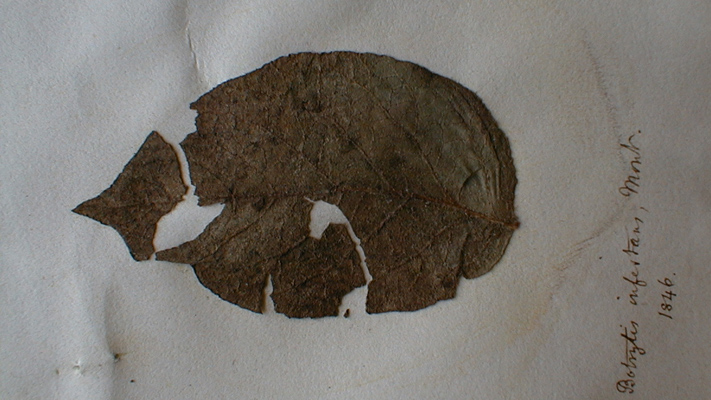Study Provides More Evidence Irish Potato Famine-Causing Pathogen Originated in South America

For Immediate Release
Research from North Carolina State University provides further evidence that the pathogen that caused the Irish potato famine in the 1840s likely originated in the Andes region of South America.
Using a robust data set, NC State plant pathologist Jean Ristaino and colleagues Mike Martin from the University of California, Berkeley and Tom Gilbert from the University of Copenhagen used whole genome DNA samples to study various strains of Phytophthora infestans, the pathogen responsible for the Irish potato famine and a major cause of late-blight disease on potato and tomato plants around the world.
The researchers used an unprecedented set of genomic sequences from 71 modern and historic samples of P. infestans. Ristaino’s lab provided DNA from the important archival samples used in the work.
“We amplified entire genomes, or sets of all genes, out of historic samples responsible for 19th century outbreaks of late-blight disease,” Ristaino said. “We sequenced from hundreds-of-years-old samples and compared the genomes to modern genome sequences of the pathogen and its close relatives.”
The study closely links P. infestans with a sister pathogen called Phytophthora andina that is only found in South America.
“What’s basal to the famine-era lineage is P. andina, a hybrid pathogen that is found only in the Andean region,” Ristaino said. “Half the genome of the historic samples is shared with P. andina, suggesting that the famine pathogen came from South America. We also think that P. infestans and P. andina diverged before modern Mexican strains of the pathogen, which further bolsters the case for a South American origin.”
The team dated the origin of the species to the 16th century – a time when Spanish explorers were entering the Western Hemisphere and were moving potatoes around the globe.
Besides characterizing a known but not well documented South American pathogen, the study provides more evidence toward solving the longstanding mystery of the origin of the Irish potato famine pathogen. Theories that P. infestans originated in Mexico also persist in the academic literature.
“What’s missing from previous studies by others are historic samples from South America that would really solve this case,” Ristaino said. “Most of the historic South American samples come from the early 20th century or later.”
P. infestans caused massive and debilitating late-blight disease outbreaks in Europe, leaving starvation and migration in its wake after ravaging Ireland in the mid-to-late 1840s. Ristaino theorizes that the pathogen arrived in Europe via infected seeds on South American ships or from the United States. The disease first arrived on U.S. shores several years prior to Irish outbreaks. Ristaino’s lab is investigating the first U.S. outbreaks in a separate study.
The pathogen’s effects aren’t limited to decimating Ireland 170 years ago. Billions are spent worldwide each year on crop damage and attempts to control the pathogen, Ristaino said. Now, researchers are looking at ways of preventing P. andina from escaping its South American confines and damaging crops in North America or elsewhere.
The study appears in the open access journal Molecular Biology and Evolution. Martin is the paper’s corresponding author. Co-authors include Filipe Vieira, Nathan Wales, Mikkel Schubert and Andaine Seguin-Orlando from the University of Copenhagen, and Simon Ho from the University of Sydney. The research was supported by grants from the Lundbeck Foundation and the Agriculture and Food Research Initiative Competitive Grants Program.
– kulikowski –
“Genomic Characterization of a South American Phytophthora Hybrid Mandates Reassessment of the Geographic Origins of Phytophthora infestans”
Authors: Michael Martin, University of California, Berkeley; Jean Ristaino, North Carolina State University; Thomas Gilbert, University of Copenhagen; et al.
Published: Nov. 17, 2015, in Molecular Biology and Evolution
DOI: 10.1093/molbev/msv241
Abstract: As the oomycete pathogen causing potato late blight disease, Phytophthora infestans triggered the famous 19th-century Irish potato famine and remains the leading cause of global commercial potato crop destruction. But the geographic origin of the genotype that caused this devastating initial outbreak remains disputed, as does the New World center of origin of the species itself. Both Mexico and South America have been proposed, generating considerable controversy. Here, we readdress the pathogen’s origins using a genomic data set encompassing 71 globally sourced modern and historical samples of P. infestans and the hybrid species P. andina, a close relative known only from the Andean highlands. Previous studies have suggested that the nuclear DNA lineage behind the initial outbreaks in Europe in 1845 is now extinct. Analysis of P. andina’s phased haplotypes recovered eight haploid genome sequences, four of which represent a previously unknown basal lineage of P. infestans closely related to the famine-era lineage. Our analyses further reveal that clonal lineages of both P. andina and historical P. infestans diverged earlier than modern Mexican lineages, casting doubt on recent claims of a Mexican center of origin. Finally, we use haplotype phasing to demonstrate that basal branches of the clade comprising Mexican samples are occupied by clonal isolates collected from wild Solanum hosts, suggesting that modern Mexican P. infestans diversified on Solanum tuberosum after a host jump from a wild species and that the origins of P. infestans are more complex than was previously thought.
- Categories:


